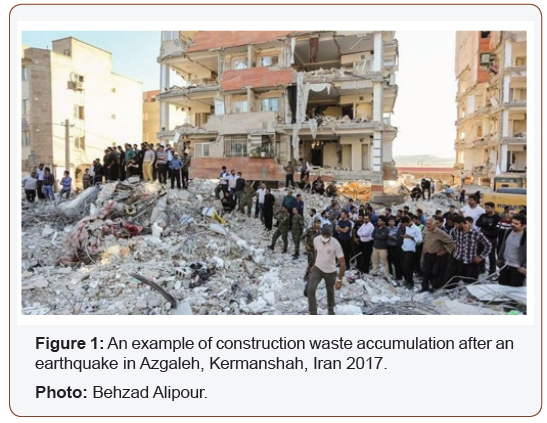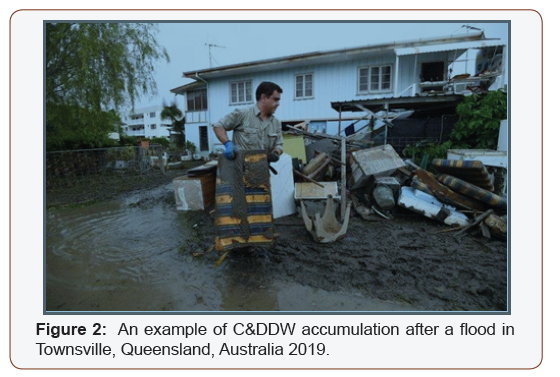 Opinion
Opinion
Construction Waste Management in Natural Disasters in Australia
Salman Shooshtarian*, Tayyab Maqsood, Peter Wong, Malik Khalfan and Rebecca Yang
School of Property, Construction and Project Management, RMIT University, Australia
Salman Shooshtarian, School of Property, Construction and Project Management, RMIT University, Australia.
Received Date: November 08, 2019; Published Date: November 12, 2019
Opinion
What is construction and demolition disaster waste?
Natural disasters can generate large quantities of waste that may directly threaten public health (e.g. direct human contact with hazardous waste such as asbestos), impede reconstruction (e.g. block access to affected populations and areas) and impact the environment. In particular, damage to infrastructure and buildings generate a significant amount of Construction Waste such as bricks, concrete and concrete rubble. This occurs in two phases: (1) when the actual natural disaster occurs and (2) later during the response and recovery activities (Figure 1).

Overview of the occurrence of natural disasters in Australia
Australian natural disasters can include heatwaves, bushfires, droughts, floods, severe storms, and tropical cyclones, earthquakes, tsunamis, and landslides. Many of these hazards are on the rise in both frequency and severity, and their financial, social and environmental impacts are tremendous. During a recent natural disaster in Queensland (in Townsville) [1], almost 3300 properties were identified to be damaged, to an extent ranging from a minor to moderate, to severe (Figure 2).

What has Australia done and not done?
There are a few national and jurisdictional initiatives to assist those who are affected by a natural disaster. The federal government has launched an initiative called ‘Disaster Assist’ [2] to provide assistance for the affected areas and people. This initiative offers information on assistance for current disasters, as well as links to previous disasters that have impacted Australians. In Queensland (Qld), the Qld Building and Construction Commission (QBCC) helps affected communities and people to recover from natural disasters by providing technical and general advice on rebuilding issues. Some states such as Qld have an exemption on levies for construction waste generated during natural disasters. In New South Wales (NSW), funding may be available to clean up waste or debris in extraordinary circumstances. In Victoria (Vic), the state government established the Victorian Bushfire Recovery and Reconstruction Authority (VBRRA) to “guide the recovery and rebuild process”. However, it seems that Australia needs to be more prepared to manage C&D waste after natural disasters. As part of this preparation, development of policies is of particular importance. The policies can define responsibilities and action plans in the event of a natural disaster. Without contingency planning, debris from a disaster has the potential to overwhelm a city’s waste and recycling infrastructure and impede disaster response and recovery activities.
Development of guidelines on the management of C&D waste in natural disasters
The issues pertaining to waste are primarily addressed and governed at the jurisdictional level. Among the jurisdictions, only the South Australian (SA) government, through the National Disaster Resilience Program, has developed a guideline on natural disaster-related construction waste management [3]. This guideline provides useful but brief information on how to manage waste should a natural disaster occurs. Other jurisdictions either do not have a policy or are in the process of developing one. For instance, the NSW’s Hunter Joint Organization of Councils is developing a Guide for the Management of Natural Disaster Waste.
What do research institutes have to offer?
The issue of Construction and Demolition (C&D) waste management has become a priority in recent years due to increased construction activities and new policies implemented by countries that once accepted C&D waste from Australia. As a result, several research projects and research funding programs have been developed to identify the major barriers to the effective management of C&D waste. At the School of Property, Construction and Project Management, RMIT University, a research is currently conducting a research project on the management of C&D waste in Australia, with a view to diverting this waste stream from landfills. This project, funded by the Australian Sustainable Built Environment National Research Centre (SBEnrc), primarily aims to address the issues arising from the implementation of disjointed waste management systems administrated by different Australian states and territories. The team believes that the management of C&D waste generated in a natural disaster needs closer attention. It advocates an integrated decision-making approach by means of policy development that targets the existing challenges. This approach should be reinforced and supported by all involved parties such as state and local governments, communities, businesses, and research institutes. One of the objectives of this research project is to assist with the development of a policy for a trading platform for C&D waste generated in construction activities as well as natural disasters.
Acknowledgement
None.
Conflict of Interest
No conflict of interest.
-
Salman Shooshtarian, Tayyab Maqsood, Peter Wong, Malik Khalfan, Rebecca Yang. Construction Waste Management in Natural Disasters in Australia. Glob J Eng Sci. 3(5): 2019. GJES.MS.ID.000573.
-
Culture, Heritage, Identity, Assuan Dam
-

This work is licensed under a Creative Commons Attribution-NonCommercial 4.0 International License.






